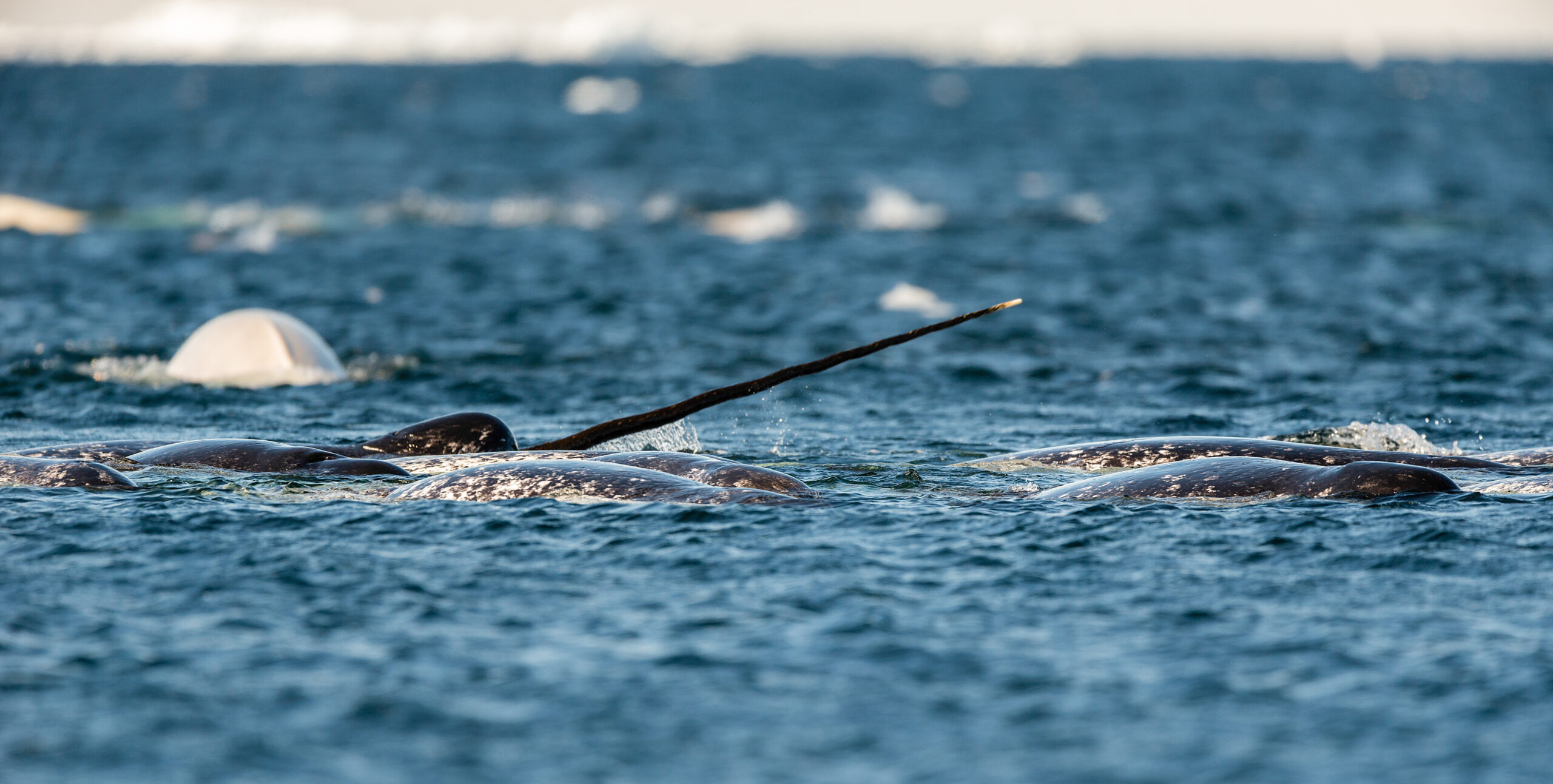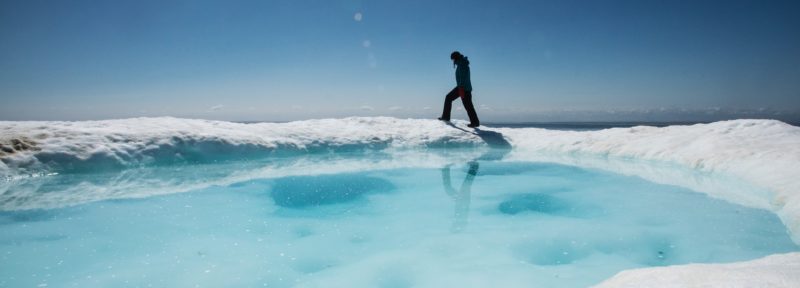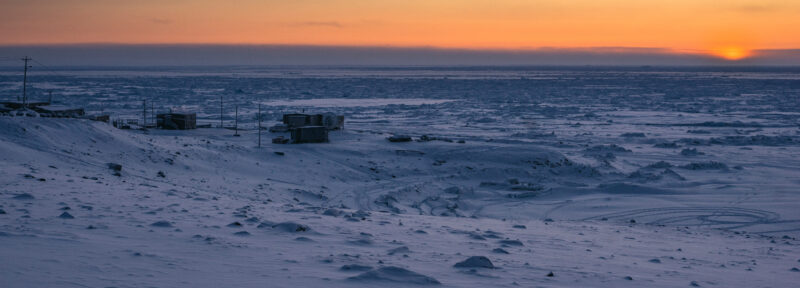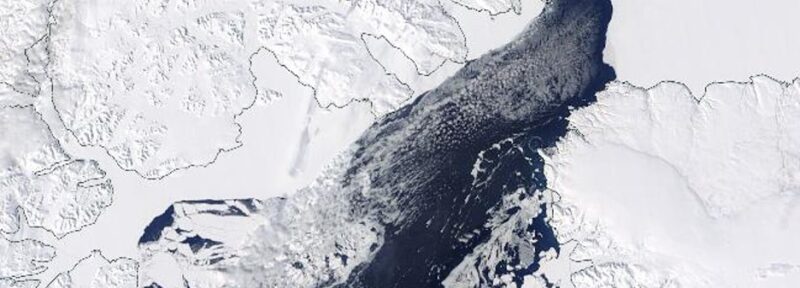The Ice Bridge: A Hotspot of Marine Biodiversity in the Arctic
Narwhal breach the surface in the North Water. Narwhal, along with other marine mammals, use this area for calving, foraging, and migration.
Credit: Adobe Stock
Welcome to the Ice Bridge, a series about the importance of the North Water Polynya. Through interviews with experts in Canada and Greenland, we’re learning more about one of the Arctic’s most fascinating ecosystems.
When researchers assess biodiversity in the Arctic, the North Water Polynya has historically been identified as one of the most important hotspots in this region – and the most biologically productive area in all of Greenland’s waters.
Spanning 85,000 square kilometres between Greenland and Canada’s Ellesmere Island, the polynya is also known as Pikialasorsuaq in Greenland, and Sarvarjuaq in Nunavut. Biologist Tom Christensen has collaborated with other scientists to compile research about this region, using international criteria to model and identify why this area is crucial to different species of marine life.
“The North Water ranks very high on both international and national scales of biodiversity,” said Christensen, who is based at Aarhus University outside of Copenhagen, Denmark.
An ivory gull flies over pack ice. The polynya is a vital feeding and nesting site for millions of migratory seabirds.
Credit: Adobe Stock
In 2017, a scientific report recommended that the North Water polynya be considered for World Heritage site status based on its biological productivity and exceptionally large concentration of High Arctic species of seabirds and marine mammals. Earlier reports have also identified the polynya as globally significant for marine biodiversity.
In 2021, Christensen served as co-chair of the 2021 Canadian Science Advisory report called “Identification of Ecological Significance, Knowledge Gaps and Stressors for the North Water and Adjacent Areas.” The report pulled together the most current research about the polynya and identified areas of concern for future monitoring and study.
The North Water’s existence is dependent on an ice bridge which forms each winter at Nares Strait on the polynya’s northern edge and holds back ice from the Central Arctic Ocean. Complex oceanographic features, including strong north winds and nutrient-rich currents, maintain the polynya’s vast area of open water throughout the winter. This also allows sunlight to penetrate each spring, nurturing an early spring bloom of plankton that is brought to the surface by an upwelling in the water column. Freshwater runoff from glaciers empties into the polynya as well, providing additional nutrients.
For marine mammals, the North Water is a hotspot in all seasons. Some species overwinter in its open waters, while others feed there and raise their young in the spring. Different High Arctic marine mammal species thrive in this area, including beluga whales, bowhead whales and narwhal, all of which use these waters for calving, foraging, and migration. The sea ice surrounding the polynya is important habitat for walrus, especially on the Greenland side where they feed on mussels and benthic fauna, Christensen said. Bearded seals, ringed seals and polar bears also congregate in this region.
In addition to supporting marine mammals, the polynya is a vital feeding and nesting site for millions of migratory seabirds. These include the world’s largest concentration of dovekies, or little auks, on the Greenland side. 80 percent of this species’ global population gathers there each year—the largest single aggregation of marine birds on earth. Greenland’s largest colonies of thick-billed murres and black-legged kittiwakes also live there. An abundance of Arctic cod, a key species in the food web, are found in the polynya, as well as Greenland halibut and other fish.
This biological richness means that for coastal communities in both Greenland and Canada, the floe edge along the polynya has long been an important area for subsistence hunting of marine mammals, seabirds, and fish.
But Christensen said that the warming of the Arctic due to climate change could possibly affect the crucial ice bridge, which is sensitive to shifts in temperature, winds and weather patterns. If the ice bridge weakens, more ice could flow into the polynya, causing changes in the area’s biological productivity.
“There are a lot of unknown factors,” Christensen said. “Seabirds and marine mammals are sensitive to climate changes. The spring plankton bloom could change. There could be a shift in the composition of the big, fat copepods in this area, which is already happening in locations further south on the west coast of Greenland. ”
Unstable sea ice conditions can also make travel to the floe edge more difficult for local communities that rely on hunting marine mammals and seabirds. At the same time, climate change is opening the region to cruise ship tourism and industrial development, which could impact marine life in the North Water.
The advisory report recommended that the polynya’s sea ice and nearby coastal glaciers be monitored to assess the impact of climate change on the North Water.
“This will require international cooperation,” Christensen said.
Future research efforts should include scientists and local communities on both sides of the North Water to better understand the impacts of climate change on this important Arctic ecosystem.
Want to learn more? Read the first post in the series here, the second post here, or watch this video to learn more about how the polynya works.
Ruth Teichroeb is a regular contributor to Oceans North and former communications director. She is based in Sidney, B.C.






